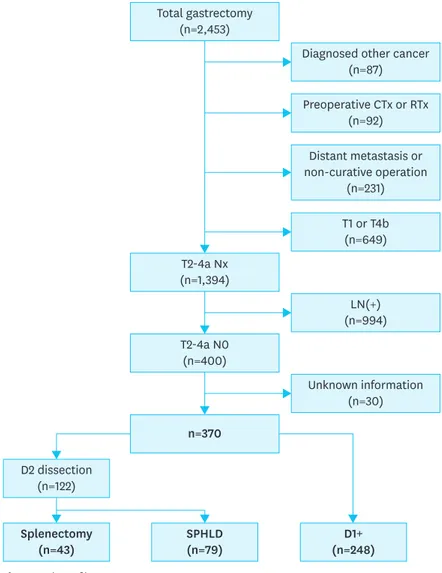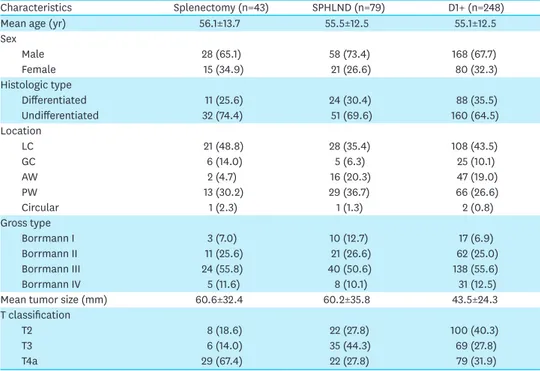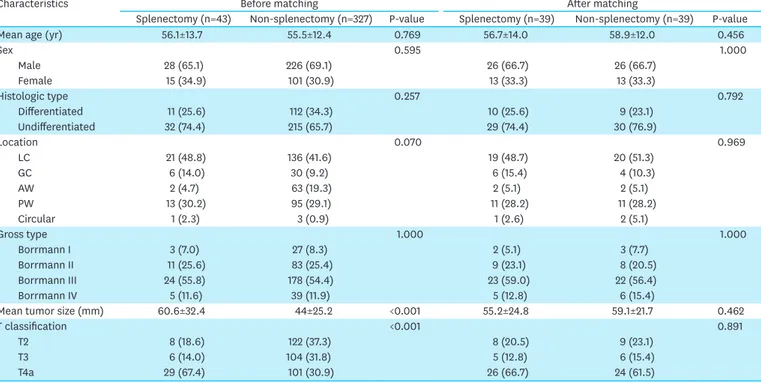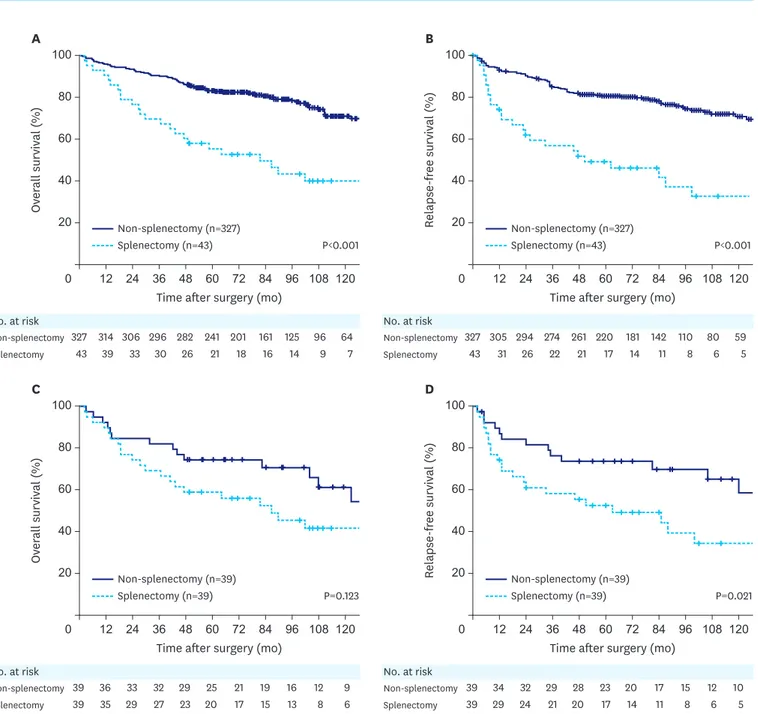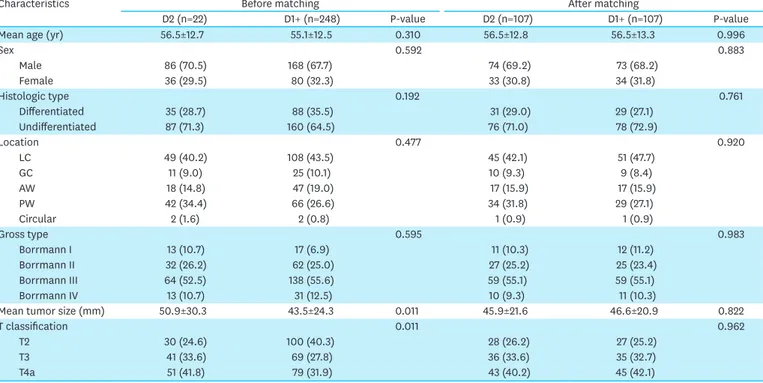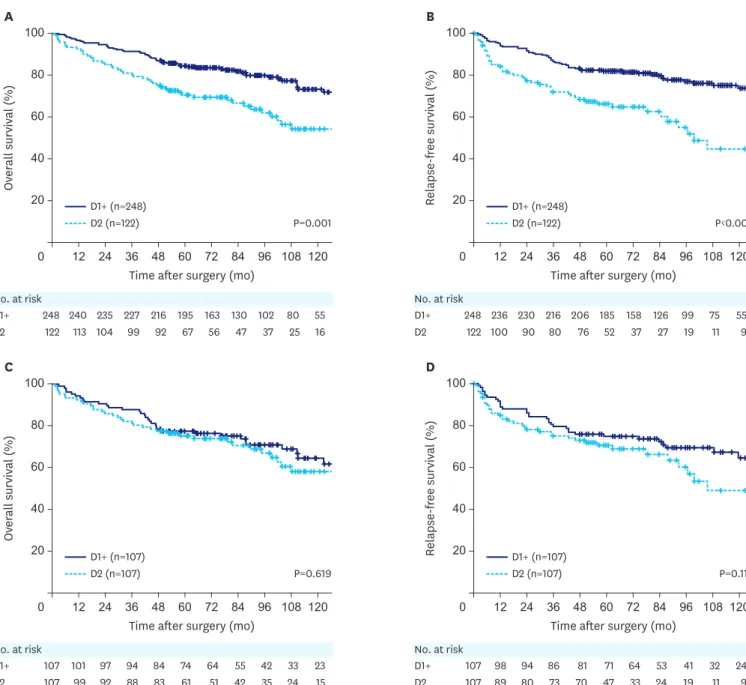ABSTRACT
Purpose: Splenic hilar lymph node dissection (LND) during total gastrectomy is regarded as the standard treatment for proximal advanced gastric cancer (AGC). This study aimed to investigate whether splenic hilar LND or D2 LND is essential for proximal AGC of pT2-4aN0M0 stage.
Materials and Methods: Data of curative total gastrectomies (n=370) performed from 2000 to 2010 for proximal AGC of pT2-4aN0 stage were retrospectively reviewed.
Clinicopathological characteristics and long-term outcomes were compared using propensity score matching between patients who underwent splenectomy (n=43) and those who did not (n=327) and between patients who underwent D2 LND (n=122) and those who underwent D1+ LND (n=248).
Results: Tumors of larger size and a more advanced T stage and significantly lower overall and relapse-free survival (P<0.001) were observed in the splenectomy group than in the 2 spleen-preserving groups. Before propensity score matching, worse overall and relapse-free survival (P<0.001) was observed in the splenectomy group than in the non-splenectomy group. After matching, although the overall survival became similar (P=0.123), relapse-free survival was worse in the splenectomy group (P=0.021). Compared with D1+ LND, D2 LND had no positive impact on the overall (P=0.619) and relapse-free survival (P=0.112) after propensity score matching.
Conclusions: Splenic hilar LND with or without splenectomy may not have an oncological benefit for patients with pathological AGC with no LN metastasis.
Keywords: Stomach neoplasms; Splenectomy; Prognosis
Original Article
Received: Dec 29, 2018 Revised: May 2, 2019 Accepted: May 19, 2019 Correspondence to Taeil SonDepartment of Surgery, Yonsei University College of Medicine, 50 Yonsei-ro, Seodaemun-gu, Seoul 03722, Korea. E-mail: tison@yuhs.ac
Copyright © 2019. Korean Gastric Cancer Association
This is an Open Access article distributed under the terms of the Creative Commons Attribution Non-Commercial License (https:// creativecommons.org/licenses/by-nc/4.0) which permits unrestricted noncommercial use, distribution, and reproduction in any medium, provided the original work is properly cited.
ORCID iDs
Sung Hyun Park
https://orcid.org/0000-0001-5116-728X Taeil Son
https://orcid.org/0000-0002-0327-5224 Won Jun Seo
https://orcid.org/0000-0003-3447-7790 Joong Ho Lee
https://orcid.org/0000-0002-8419-1099 Youn Young Choi
https://orcid.org/0000-0002-2179-7851 Hyoung-Il Kim
https://orcid.org/0000-0002-6134-4523 Jae-Ho Cheong
https://orcid.org/0000-0002-1703-1781 Sung Hoon Noh
https://orcid.org/0000-0003-4386-6886 Woo Jin Hyung
https://orcid.org/0000-0002-8593-9214
Sung Hyun Park 1,2, Taeil Son 1,2, Won Jun Seo 1,2, Joong Ho Lee 3,
Youn Young Choi 1,2, Hyoung-Il Kim 1,2, Jae-Ho Cheong 1,2, Sung Hoon Noh 1,2,
Woo Jin Hyung 1,2
1Department of Surgery, Yonsei University College of Medicine, Seoul, Korea 2Gastric Cancer Center, Yonsei Cancer Center, Seoul, Korea
3Department of Surgery, National Health Insurance Service Ilsan Hospital, Goyang, Korea
Prognostic Impact of Extended Lymph
Node Dissection versus Limited Lymph
Node Dissection on pN0 Proximal
Advanced Gastric Cancer:
Funding
This study was supported by a new faculty research seed money grant from Yonsei University College of Medicine for 2016 (2016-32-0024).
Author Contributions
Conceptualization: P.S.H., S.T., H.W.J.; Data curation: P.S.H., S.T.; Formal analysis: P.S.H., S.W.J., L.J.H.; Funding acquisition: S.T.; Investigation: P.S.H., S.T., S.W.J., L.J.H., H.W.J.; Methodology: P.S.H., S.T., S.W.J., L.J.H., H.W.J.; Supervision: C.Y.Y., K.H.I., C.J.H., N.S.H.; Validation: C.Y.Y., K.H.I., C.J.H., N.S.H.; Writing - original draft: P.S.H., S.T.; Writing - review & editing: C.Y.Y., K.H.I., C.J.H., N.S.H.
Conflict of Interest
All authors have completed the disclosure declaration, and none of the authors or their immediate family members report a conflicting financial interest.
Presentation
This study was presented in the plenary session at the Korea International Gastric Cancer Week (KINGCA) 2018, Seoul in April 2018.
INTRODUCTION
In cancer treatment, adequate surgical resection, including lymph node dissection (LND), is essential to achieve a curative state. In advanced gastric cancer (AGC), total or subtotal gastrectomy with D2 LND is widely performed as the standard treatment [1-3]. Since proximal gastric cancer, which has a steadily rising incidence [4], metastasizes to the splenic hilar lymph nodes (LNs; station No. 10) in 9%–26% [5-8], D2 LND, including splenic hilar LND, is recommended for proximal AGC as per previous treatment guidelines [9]. To remove splenic hilar LNs, surgeons should perform splenectomy or spleen-preserving hilar LND. The theoretical background for the removal of splenic hilar LNs in AGC has been explored using lymphangiography [10]. With evidence of lymphatic flow from the upper greater curvature through the splenic hilum to the celiac trunk, splenectomy has been considered as an effective method for performing en-bloc resection of gastric cancer and adjacent LNs [10]. However, because of compromised immunological functions along with high morbidity and mortality rates, splenectomy poses serious adverse effects [11-13]. Meanwhile, because surgical techniques have improved, some experienced surgeons perform spleen-preserving hilar LND, which could be an ideal method [14,15]. Nevertheless, although this procedure is theoretically rational, it is technically challenging, and the oncological validity of the procedure remains unclear [14]. Thus, splenectomy and spleen-preserving hilar dissection should be avoided, if possible, because of the difficulty in the procedure and other aspects.
In previous Japanese guidelines, the decision of performing hilar LND was based on clinical T classification of cancer (T2 or more advanced lesion). However, the recently revised guidelines do not include splenic hilar LND for all proximal advanced cancers unless it involves the greater curvature of the stomach. However, even among the indicated patients, there may be patients who would gain little benefit or even detrimental effects from hilar dissection. Identifying the characteristics of this group of patients could be useful to prevent unnecessary hilar dissection.
In the present study, we presumed that pT2-4aN0 patients would not gain any additional oncological benefits from hilar dissection. Accordingly, we aimed to determine the survival impact of splenectomy or splenic hilar dissection in the proximal AGC patients without LN metastasis who underwent curative total gastrectomy. We also sought to investigate whether D2 LND, including splenectomy and spleen-preserving hilar dissection, should be mandatory for LN negative proximal AGC.
MATERIALS AND METHODS
Patients
By retrospectively analyzing our prospectively collected database from the Department of Surgery, Yonsei University College of Medicine from 2000 to 2010, we identified 2,453 patients who underwent total gastrectomy for gastric cancer. Of these, 2,083 patients were excluded (87 patients were diagnosed with other malignancies before the operation and 92 patients were treated with preoperative chemotherapy or radiotherapy). A total of 231 patients underwent non-curative surgery, among whom 120 had peritoneal seeding; 81 had positive washing cytology or other organ metastasis, including para-aortic LN
metastasis; and 30 were not treated with R0 resection. Among the remaining patients, 400 met the pathological T2-4aN0 criteria, among whom 30 patients having incomplete clinicopathological information were excluded. Finally, 370 patients were included in the analysis (Fig. 1). The clinicopathological characteristics (age, sex, histological differentiation, tumor location, gross type, size, and T classification) of the 370 patients were analyzed. This retrospective study was approved by the Institutional Review Board (IRB) of Severance Hospital Yonsei University College of Medicine (4-2017-0711). Because of the retrospective nature of the study, signed patient informed consent was waived as per the IRB approval.
Operation
Curative total gastrectomy with LND was performed following the Japanese Gastric Cancer Association (JGCA) classification guidelines [9]. A total of 370 patients underwent total gastrectomy with LND by open, laparoscopic, or robot-assisted methods for gastric cancer. The patients who met the indications of minimally invasive surgery at our institution were able to select the surgical procedure after receiving information on the advantages and disadvantages of each procedure.
Total gastrectomy (n=2,453) T2-4a Nx (n=1,394) T2-4a N0 (n=400) SPHLD (n=79) Splenectomy (n=43) D2 dissection (n=122) D1+ (n=248)
Diagnosed other cancer (n=87) Preoperative CTx or RTx (n=92) Distant metastasis or non-curative operation (n=231) T1 or T4b (n=649) LN(+) (n=994) n=370 Unknown information (n=30)
Survival impact of splenectomy on node negative T2-4a gastric cancer patients
For the current study, we divided the patients into 3 groups: splenectomy group, spleen-preserving hilar LND group (SPHLD group), and a group of patients in whom the extent of LND was not up to D2 dissection (D1+). To verify the survival impact of splenectomy on patients with proximal AGC, the splenectomy group was compared with the other 2 non-splenectomy groups (SPHLND+D1+) in terms of clinicopathological characteristics and long-term survival. Because the surgical treatment method or extent was pre-delong-termined based on clinicopathological characteristics, we expected the study groups to show significant differences in perioperative outcomes, which we corrected using propensity score matching analysis. Accordingly, the long-term outcomes were compared by assessing overall and relapse-free survival among the groups before and after propensity score matching.Survival impact of D2 LND on node negative T2-4a gastric cancer patients
In addition, the splenectomy plus SPHLD groups, which underwent D2 LND, were compared with the D1+ group to verify the oncological impact of D2 LND on node-negative T2-4a gastric cancer patients. In the same way, the clinicopathological characteristics and long-term outcomes were analyzed for the D2 group and compared with the D1+ group.Statistical analyses
The clinicopathological and long-term oncological results, including overall and relapse-free survival, were analyzed using the R package survival and Matchit (version 3.3.1). To minimize selection bias, seven perioperative variables representative of patient features (age and sex) and tumor characteristics (histological type, location, gross type, size, and T classification) were selected and matched 1:1 using propensity score matching, as these variables are considered to have a significant impact on patient survival. The patients were followed from the date of operation until December 31, 2014, or their death. Overall survival was defined from the date of operation to the last follow-up or death from any cause. Relapse-free survival was defined from the date of operation to recurrence of gastric cancer or death from any cause. The patients were censored at the last follow-up if they did not experience the designated events. The overall and relapse-free survival were assessed using the Kaplan-Meier method, and the differences in survival curves among the groups were examined using the log-rank test. The categorical and continuous variables were analyzed by the χ2 or Fisher's exact and Student's t-test, respectively. All P-values <0.05 (2-sided) were considered statistically significant. Multivariate analyses to assess the risk factors for overall survival were performed using the Cox proportional hazard model. The following variables were included in the analyses: age, sex, location, differentiation, Borrmann type, tumor size, and type of operation.
RESULTS
Demographic characteristics of the patients among the different groups and
comparison of long-term survival
Among the 370 patients who underwent total gastrectomy for pT2-4aN0 proximal AGC, 43 patients underwent splenectomy, and 79 patients underwent spleen-preserving hilar LND. The remaining 248 patients underwent surgery with limited LND, excluding station No. 10. The splenectomy group tended to have more advanced disease (Table 1). In the comparison of survival curves among the splenectomy, SPHLD, and D1+ groups, the splenectomy group had worse overall survival than the other 2 groups (P<0.001 for D1+, P=0.003 for SPHLD).
Relapse-free survival was also worse in the splenectomy group than the other two groups (P<0.001 for D1+, P=0.003 for SPHLD). There were no differences in the overall and relapse-free survival between the SPHLD and D1+ groups (P=0.239 and P=0.061, respectively; Fig. 2).
Table 1. Demographics of patients in the splenectomy, SPHLD, and D1+ groups
Characteristics Splenectomy (n=43) SPHLND (n=79) D1+ (n=248)
Mean age (yr) 56.1±13.7 55.5±12.5 55.1±12.5
Sex Male 28 (65.1) 58 (73.4) 168 (67.7) Female 15 (34.9) 21 (26.6) 80 (32.3) Histologic type Differentiated 11 (25.6) 24 (30.4) 88 (35.5) Undifferentiated 32 (74.4) 51 (69.6) 160 (64.5) Location LC 21 (48.8) 28 (35.4) 108 (43.5) GC 6 (14.0) 5 (6.3) 25 (10.1) AW 2 (4.7) 16 (20.3) 47 (19.0) PW 13 (30.2) 29 (36.7) 66 (26.6) Circular 1 (2.3) 1 (1.3) 2 (0.8) Gross type Borrmann I 3 (7.0) 10 (12.7) 17 (6.9) Borrmann II 11 (25.6) 21 (26.6) 62 (25.0) Borrmann III 24 (55.8) 40 (50.6) 138 (55.6) Borrmann IV 5 (11.6) 8 (10.1) 31 (12.5)
Mean tumor size (mm) 60.6±32.4 60.2±35.8 43.5±24.3
T classification
T2 8 (18.6) 22 (27.8) 100 (40.3)
T3 6 (14.0) 35 (44.3) 69 (27.8)
T4a 29 (67.4) 22 (27.8) 79 (31.9)
Data are shown as a mean±standard deviation or number of patients (proportion).
SPHLD = spleen-preserving hilar lymph node dissection; LN = lymph node; LC = lesser curvature; GC = greater curvature; AW = anterior wall; PW = posterior wall.
Time after surgery (mo)
A Ov er all survival (%) 60 0 120 100 80 40 20 108 96 84 72 60 48 36 24 12 No. at risk D1+ SPHLD 79 74 71 68 66 46 38 31 23 16 9
Time after surgery (mo)
B Relapse-free survival (%) 60 0 120 100 80 40 20 108 96 84 72 60 48 36 24 12 No. at risk D1+ SPHLD 79 69 64 58 55 37 23 16 11 5 4 Splenectomy 43 39 33 30 26 21 18 16 14 9 7 Splenectomy 43 31 26 22 21 17 14 11 8 6 5 P<0.001 P=0.239 P=0.003 SPHLD (n=79) Splenectomy (n=43) D1+ (n=248) 248 240 235 227 216 195 163 130 102 80 55 248 236 230 216 206 185 158 126 99 75 55 P<0.001 P=0.061 P=0.003 SPHLD (n=79) Splenectomy (n=43) D1+ (n=248)
Fig. 2. Kaplan-Meier overall and relapse-free survival curves for patients with splenectomy, SPHLD, and D1+ groups. (A) Overall survival among the 3 groups.
(B) R-free survival among the 3 groups.
Comparison of the characteristics before and after propensity score
matching between the splenectomy and non-splenectomy groups
To investigate the impact of splenectomy on pT2-4aN0 patients, the two non-splenectomy groups were combined and compared with the splenectomy group (splenectomy group [n=43] vs. non-splenectomy group [n=327, SPHLD+D1+]) (Table 2). In this comparison, a few clinicopathological characteristics were found to be significantly different between the 2 groups: The mean tumor size of the splenectomy group was 60.6 mm, whereas that in the non-splenectomy group was 44.0 mm (P<0.001). Furthermore, compared with the non-splenectomy group, the splenectomy group had an advanced T classification (P<0.001). After 1:1 propensity score matching for seven variables, 39 pairs of patients with similar clinicopathological characteristics, including age, sex, histological type, location, gross type, size, and T classification, were matched (P>0.05).
Comparison of long-term outcomes between the splenectomy and
non-splenectomy groups
Comparing the survival curves, worse overall and relapse-free survival were observed in the splenectomy group (n=43) than in the non-splenectomy group (n=327) (P<0.001 and P<0.001, respectively) (Fig. 3A and B). After propensity score matching, a comparison of 39 matched pairs showed similar overall survival but worse relapse-free survival in the splenectomy group (P=0.123 and P=0.021, respectively) compared with those in the non-splenectomy group (Fig. 3C and D).
Table 2. Demographics of patients before and after propensity score matching between the splenectomy and non-splenectomy (SPHLD+D1+) groups
Characteristics Before matching After matching
Splenectomy (n=43) Non-splenectomy (n=327) P-value Splenectomy (n=39) Non-splenectomy (n=39) P-value
Mean age (yr) 56.1±13.7 55.5±12.4 0.769 56.7±14.0 58.9±12.0 0.456
Sex 0.595 1.000 Male 28 (65.1) 226 (69.1) 26 (66.7) 26 (66.7) Female 15 (34.9) 101 (30.9) 13 (33.3) 13 (33.3) Histologic type 0.257 0.792 Differentiated 11 (25.6) 112 (34.3) 10 (25.6) 9 (23.1) Undifferentiated 32 (74.4) 215 (65.7) 29 (74.4) 30 (76.9) Location 0.070 0.969 LC 21 (48.8) 136 (41.6) 19 (48.7) 20 (51.3) GC 6 (14.0) 30 (9.2) 6 (15.4) 4 (10.3) AW 2 (4.7) 63 (19.3) 2 (5.1) 2 (5.1) PW 13 (30.2) 95 (29.1) 11 (28.2) 11 (28.2) Circular 1 (2.3) 3 (0.9) 1 (2.6) 2 (5.1) Gross type 1.000 1.000 Borrmann I 3 (7.0) 27 (8.3) 2 (5.1) 3 (7.7) Borrmann II 11 (25.6) 83 (25.4) 9 (23.1) 8 (20.5) Borrmann III 24 (55.8) 178 (54.4) 23 (59.0) 22 (56.4) Borrmann IV 5 (11.6) 39 (11.9) 5 (12.8) 6 (15.4)
Mean tumor size (mm) 60.6±32.4 44±25.2 <0.001 55.2±24.8 59.1±21.7 0.462
T classification <0.001 0.891
T2 8 (18.6) 122 (37.3) 8 (20.5) 9 (23.1)
T3 6 (14.0) 104 (31.8) 5 (12.8) 6 (15.4)
T4a 29 (67.4) 101 (30.9) 26 (66.7) 24 (61.5)
Data are shown as a mean±standard deviation or number of patients (proportion).
Comparison of the characteristics before and after propensity score
matching between the D2 and the D1+ groups
To investigate the impact of D2 LND, the D2 group (n=122, splenectomy+SPHLD) was compared with the D1+ group (n=248) (Table 3). More advanced disease (larger tumor size and higher T classification) was observed in the D2 group than in the D1+ group (P=0.011 and P=0.011, respectively). After 1:1 propensity score matching with the same seven variables, 107 pairs of patients with similar clinicopathological features were matched (P>0.05).
Time after surgery (mo)
A Ov er all survival (%) 60 0 120 100 80 40 20 108 96 84 72 60 48 36 24 12 No. at risk Non-splenectomy Splenectomy 327 43 314 39 306 33 296 30 282 26 241 21 201 18 161 16 125 14 96 9 64 7
Time after surgery (mo)
B Relapse-free survival (%) 60 0 120 100 80 40 20 108 96 84 72 60 48 36 24 12 No. at risk Non-splenectomy Splenectomy 327 43 305 31 294 26 274 22 261 21 220 17 181 14 142 11 110 8 80 6 59 5 P<0.001 P<0.001 Non-splenectomy (n=327) Splenectomy (n=43) Non-splenectomy (n=327) Splenectomy (n=43)
Time after surgery (mo)
C Ov er all survival (%) 60 0 120 100 80 40 20 108 96 84 72 60 48 36 24 12 No. at risk Non-splenectomy Splenectomy 39 39 36 35 33 29 32 27 29 23 25 20 21 17 19 15 16 13 12 8 9 6
Time after surgery (mo)
D Relapse-free survival (%) 60 0 120 100 80 40 20 108 96 84 72 60 48 36 24 12 No. at risk Non-splenectomy Splenectomy 39 39 34 29 32 24 29 21 28 20 23 17 20 14 17 11 15 8 12 6 10 5 P=0.123 P=0.021 Non-splenectomy (n=39) Splenectomy (n=39) Non-splenectomy (n=39) Splenectomy (n=39)
Fig. 3. Kaplan-Meier overall and relapse-free survival curves for patients with splenectomy compared with those for patients with non-splenectomy (SPHLD+D1+)
before and after propensity score matching. (A) Overall survival before matching (P<0.001). (B) Relapse-free survival before matching (P<0.001). (C) Overall survival after matching (P=0.123). (D) Relapse-free survival after matching (P=0.021).
Comparison of long-term outcomes between the D2 and the D1+ groups
When comparing the survival curves between the D2 and the D1+ groups before propensity score matching, the D2 group had worse overall and relapse-free survival than the D1+ group (P=0.001 and P<0.001, respectively) (Fig. 4A and B). After propensity score matching, comparison of the 107 matched pairs revealed similar overall and relapse-free survival between the 2 groups (P= 0.619 and P=0.112, respectively) (Fig. 4C and D).Recurrence patterns
During the median follow-up period of 93.3 months, 52 of 370 patients (13, 7, and 32 patients in the splenectomy, SPHLD, and D1+ groups, respectively) were found to have a recurrence. Among them, spleen or splenic hilar LN recurrence was found in 3 (1.2%) patients. The first patient (54-year-old male) had T4aN0 cancer located on the lesser curvature and underwent D1+ LND. He experienced a recurrence in the splenic hilar and the paraaortic LNs at 36 months after the primary operation. The second patient (64-year-old male) had T2N0 cancer located on the posterior wall and underwent D1+ LND. He had recurrence at the splenic hilar and the paraaortic LNs at 39 months after the operation. These patients were treated with palliative chemotherapy after diagnosis of recurrence but died within 6 and 18 months. The third patient (40-year-old male) underwent D1+ LND for cancer (pT3N0) located at the greater curvature. He had recurrence only at the splenic hilum. Splenectomy was followed, and 12 metastatic LNs were found among 14 dissected LNs. This patient was followed up and remained disease-free for more than 6 years.
Cox proportional hazard model for multivariate analysis
In a multivariate analysis to identify risk factors for overall survival using Cox proportional hazard model, hazard ratios (HRs) of the SPHLD group and D1+ group were 0.49 (95%
Table 3. Demographics of patients before and after propensity score matching between D2 dissection (splenectomy+SPHLD) and D1+ groups
Characteristics Before matching After matching
D2 (n=22) D1+ (n=248) P-value D2 (n=107) D1+ (n=107) P-value
Mean age (yr) 56.5±12.7 55.1±12.5 0.310 56.5±12.8 56.5±13.3 0.996
Sex 0.592 0.883 Male 86 (70.5) 168 (67.7) 74 (69.2) 73 (68.2) Female 36 (29.5) 80 (32.3) 33 (30.8) 34 (31.8) Histologic type 0.192 0.761 Differentiated 35 (28.7) 88 (35.5) 31 (29.0) 29 (27.1) Undifferentiated 87 (71.3) 160 (64.5) 76 (71.0) 78 (72.9) Location 0.477 0.920 LC 49 (40.2) 108 (43.5) 45 (42.1) 51 (47.7) GC 11 (9.0) 25 (10.1) 10 (9.3) 9 (8.4) AW 18 (14.8) 47 (19.0) 17 (15.9) 17 (15.9) PW 42 (34.4) 66 (26.6) 34 (31.8) 29 (27.1) Circular 2 (1.6) 2 (0.8) 1 (0.9) 1 (0.9) Gross type 0.595 0.983 Borrmann I 13 (10.7) 17 (6.9) 11 (10.3) 12 (11.2) Borrmann II 32 (26.2) 62 (25.0) 27 (25.2) 25 (23.4) Borrmann III 64 (52.5) 138 (55.6) 59 (55.1) 59 (55.1) Borrmann IV 13 (10.7) 31 (12.5) 10 (9.3) 11 (10.3)
Mean tumor size (mm) 50.9±30.3 43.5±24.3 0.011 45.9±21.6 46.6±20.9 0.822
T classification 0.011 0.962
T2 30 (24.6) 100 (40.3) 28 (26.2) 27 (25.2)
T3 41 (33.6) 69 (27.8) 36 (33.6) 35 (32.7)
T4a 51 (41.8) 79 (31.9) 43 (40.2) 45 (42.1)
Data are shown as a mean±standard deviation or number of patients (proportion).
confidence interval [CI], 0.26–0.91; P=0.023) and 0.41 (95% CI, 0.24–0.68; P<0.001), respectively, compared with those of the splenectomy group (Supplementary Fig. 1).
DISCUSSION
In this study, we found that prior to propensity score matching, patients with splenectomy tended to have tumors of larger size and more advanced T classification than patients who did not undergo splenectomy. Thus, we performed a propensity score matching to correct the differences in clinicopathological characteristics due to selection bias that could Time after surgery (mo)
A Ov er all survival (%) 60 0 120 100 80 40 20 108 96 84 72 60 48 36 24 12 No. at risk D1+ D2 248 122 240 113 235 104 227 99 216 92 195 67 163 56 130 47 102 37 80 25 55 16
Time after surgery (mo)
B Relapse-free survival (%) 60 0 120 100 80 40 20 108 96 84 72 60 48 36 24 12 No. at risk D1+ D2 248 122 236 100 230 90 216 80 206 76 185 52 158 37 126 27 99 19 75 11 55 9 P=0.001 P<0.001 D1+ (n=248) D2 (n=122) D1+ (n=248) D2 (n=122)
Time after surgery (mo)
C Ov er all survival (%) 60 0 120 100 80 40 20 108 96 84 72 60 48 36 24 12 No. at risk D1+ D2 107 107 101 99 97 92 94 88 84 83 74 61 64 51 55 42 42 35 33 24 23 15
Time after surgery (mo)
D Relapse-free survival (%) 60 0 120 100 80 40 20 108 96 84 72 60 48 36 24 12 No. at risk D1+ D2 107 107 98 89 94 80 86 73 81 70 71 47 64 33 53 24 41 19 32 11 24 9 P=0.619 P=0.112 D1+ (n=107) D2 (n=107) D1+ (n=107) D2 (n=107)
Fig. 4. Kaplan-Meier overall and relapse-free survival curves for patients with D2 LN dissection (splenectomy+SPHLD) compared with those for patients with
D1+ before and after propensity score matching. (A) Overall survival before matching (P=0.001). (B) Relapse-free survival before matching (P<0.001). (C) Overall survival after matching (P=0.619). (D) Relapse-free survival after matching (P=0.112).
skew oncological results. After propensity score matching, we noted no difference in the clinicopathological characteristics between patients who underwent splenectomy and those who did not. Similar results were obtained with patients who underwent D2 LND compared with those who underwent D1+ dissection. Survival curves after propensity score matching suggested that neither splenectomy nor D2 LND had a positive impact on long-term survival in patients with LN-negative T2-4a AGC.
The controversy surrounding the benefits of splenectomy to oncological outcomes in gastric cancer regardless of LN involvement has been longstanding. Previous reports have shown that splenectomy offers no survival benefit in the presence of metastatic LN [8,16]. Meanwhile, the recently published JCOG0110 trial, which compared splenectomy group with a non-splenectomy group for clinical AGC (cT2-4/N0-2) not invading the greater curvature, concluded that splenectomy was not superior to spleen preservation [17,18]. However, a recent report from our institution demonstrated that splenic hilar LND during splenectomy or with spleen preservation had a positive impact on long-term survival similar to that with the removal of other extra-perigastric LN groups [19]. Watanabe et al. [20] also reported from a single institutional data that splenectomy offers a survival benefit when cancer involves the greater curvature. In this study, the LN positive ratio was 68.2% in cancers involving the greater curvature [20]. Additionally, Ji et al. [21] recently reported that spleen-preserving hilar dissection elicited better survival than splenectomy for upper and middle third AGC. Thus, dissecting hilar LNs and preserving the spleen could be desirable in certain patients with proximal AGC. In the current study, we focused on patients who could be exempted from splenectomy or splenic hilar dissection although they had advanced diseases. Thereby, we were able to analyze the impacts of splenectomy and D2 LND in patients with an advanced disease without LN metastasis. Our results suggest that the potential hazards posed by these procedures may outweigh their benefits in this specific group of patients.
After the results of JCOG 0110 trial were published, there was a drive to alter the extent of LND in proximal AGC. Because this trial did not include tumors located in the greater curvature, it was considered that tumors on the other side of the proximal stomach could be indicated for limited LND. In this regard, Kinoshita [22] recently suggested 3 different procedures as follows: D2-No. 10, spleen-preserving D2, and splenectomy D2. In addition, according to the latest guidelines revised in 2018, splenic hilar LND is not necessary unless cancer involves the greater curvature of the stomach. However, in the JCOG 0110 trial, N0 cancer accounted for 42.2% (213/505) of all cancers. Thus, there was a possibility of decreased survival in the splenectomy group because of the potential adverse oncological impact of splenectomy on N0 cancer, although in the subgroup analysis of the study, contrary to our expectations, splenectomy in patients with N0 cancer tended to have a positive impact on the survival (HR, 1.23; 95% CI, 0.68–2.25) [17]. In this study, we tried to investigate whether it is possible to identify patients who do not require splenic hilar LND based on tumor factors, including the location. Accordingly, we suggested that patients with T2-4aN0M0 tumors, which are classified as stage IB–IIB based on the 7th Union for International Cancer Control/American Joint Committee on Cancer TNM staging system, could be the ideal candidates for limited LND regardless of tumor location. These patients in our database comprised 28.7% of the patients for whom D2 LND was indicated with a curative aim.
Herein, we showed the survival impact of splenectomy or D2 LND in patients with pT2-4aN0M0 cancer involving a large amount of data using propensity score matching.
However, there are some limitations to this study. The critical limitation of our study is that we compared pathological findings. Thus, it would be difficult to apply these results to clinical practice, because the current preoperative diagnosis is limited to predicting pN0 cancer. While computed tomography (CT), endoscopic ultrasound, and positron emission tomography-CT are used for gastric cancer staging before surgery, their sensitivity and specificity are not high enough to confirm nodal involvement [23]. Although Tokunaga et al. [24] showed that clinical findings have an effect on the survival outcomes even among patients with the same pathological findings, we attempted to identify the specific patient group which does not require splenectomy or splenic hilar LND by analyzing the pathological data. Nevertheless, with ongoing research, we expect that the accuracy of the preoperative diagnosis of N classification will improve with time, and our results could be more applicable for the accurate preoperative prediction of N classification. Secondly, our study was performed as a retrospective analysis using data from a single institution. Although the reasons for splenectomy were sometimes unclear, we tried to reduce selection bias by excluding T4b cancer and using propensity score matching. In addition, our data could be considered robust because these were derived from the results of a standardized treatment administered by experienced surgeons from a center with a high volume of patients with gastric cancer. For instance, although the extent of LND did not adhere to the standard treatment guidelines in the D1+ group, more than 40 LNs were retrieved, which was much greater than the 16 LNs required for proper staging (50.7, 46.6, and 42.9 in splenectomy, SPHLD, and D1+ groups, respectively). Furthermore, there was no accurate information on postoperative adjuvant chemotherapy which might have an impact on the survival. However, in general, gastric cancer patients in stage II or higher received our institution's standard 5-fluorouracil-based adjuvant chemotherapy since early 2000. Finally, even after propensity score matching, there were still differences in the clinicopathological characteristics and unseen bias due to latent variables, although we tried to reduce the bias by matching the patients for seven clinically important characteristics known to affect survival after treatment.
In conclusion, we found that splenectomy does not have an oncological benefit in patients with LN-negative AGC. In addition, we deemed D2 LND to be unnecessary for these patients. Although the accuracy of current preoperative nodal classification is not high enough, our results could play an important role in determining and revising the extent of LND for the treatment of proximal AGC.
SUPPLEMENTARY MATERIAL
Supplementary Fig. 1
Multivariate analysis to identify risk factors for overall survival using the Cox proportional hazard model.
Click here to view
REFERENCES
1. Songun I, Putter H, Kranenbarg EM, Sasako M, van de Velde CJ. Surgical treatment of gastric cancer: 15-year follow-up results of the randomised nationwide Dutch D1D2 trial. Lancet Oncol 2010;11:439-449.
2. Sano T, Sasako M, Yamamoto S, Nashimoto A, Kurita A, Hiratsuka M, et al. Gastric cancer surgery: morbidity and mortality results from a prospective randomized controlled trial comparing D2 and extended para-aortic lymphadenectomy--Japan Clinical Oncology Group study 9501. J Clin Oncol 2004;22:2767-2773.
PUBMED | CROSSREF
3. Ferlay J, Soerjomataram I, Dikshit R, Eser S, Mathers C, Rebelo M, et al. Cancer incidence and mortality worldwide: sources, methods and major patterns in GLOBOCAN 2012. Int J Cancer 2015;136:E359-E386.
PUBMED | CROSSREF
4. Blot WJ, Devesa SS, Kneller RW, Fraumeni JF Jr. Rising incidence of adenocarcinoma of the esophagus and gastric cardia. JAMA 1991;265:1287-1289.
PUBMED | CROSSREF
5. Ikeguchi M, Kaibara N. Lymph node metastasis at the splenic hilum in proximal gastric cancer. Am Surg 2004;70:645-648.
PUBMED
6. Meyer HJ, Jähne J, Weimann A, Pichlmayr R. Surgical therapy of stomach cancer--indications for splenectomy in gastrectomy. Chirurg 1994;65:437-440.
PUBMED
7. Mönig SP, Collet PH, Baldus SE, Schmackpfeffer K, Schröder W, Thiele J, et al. Splenectomy in proximal gastric cancer: frequency of lymph node metastasis to the splenic hilus. J Surg Oncol 2001;76:89-92.
PUBMED | CROSSREF
8. Yu W, Choi GS, Chung HY. Randomized clinical trial of splenectomy versus splenic preservation in patients with proximal gastric cancer. Br J Surg 2006;93:559-563.
PUBMED | CROSSREF
9. Japanese Gastric Cancer Association. Japanese classification of gastric carcinoma: 3rd English edition. Gastric Cancer 2011;14:101-112.
PUBMED | CROSSREF
10. Maruyama K, Okabayashi K, Kinoshita T. Progress in gastric cancer surgery in Japan and its limits of radicality. World J Surg 1987;11:418-425.
PUBMED | CROSSREF
11. Kosuga T, Ichikawa D, Okamoto K, Komatsu S, Shiozaki A, Fujiwara H, et al. Survival benefits from splenic hilar lymph node dissection by splenectomy in gastric cancer patients: relative comparison of the benefits in subgroups of patients. Gastric Cancer 2011;14:172-177.
PUBMED | CROSSREF
12. Bonenkamp JJ, Hermans J, Sasako M, van de Velde CJ, Welvaart K, Songun I, et al. Extended lymph-node dissection for gastric cancer. N Engl J Med 1999;340:908-914.
PUBMED | CROSSREF
13. Cuschieri A, Weeden S, Fielding J, Bancewicz J, Craven J, Joypaul V, et al. Patient survival after D1 and D2 resections for gastric cancer: long-term results of the MRC randomized surgical trial. Br J Cancer 1999;79:1522-1530.
PUBMED | CROSSREF
14. Hyung WJ, Lim JS, Song J, Choi SH, Noh SH. Laparoscopic spleen-preserving splenic hilar lymph node dissection during total gastrectomy for gastric cancer. J Am Coll Surg 2008;207:e6-e11.
PUBMED | CROSSREF
15. Oh SJ, Hyung WJ, Li C, Song J, Kang W, Rha SY, et al. The effect of spleen-preserving lymphadenectomy on surgical outcomes of locally advanced proximal gastric cancer. J Surg Oncol 2009;99:275-280.
PUBMED | CROSSREF
16. Maehara Y, Moriguchi S, Yoshida M, Takahashi I, Korenaga D, Sugimachi K. Splenectomy does not correlate with length of survival in patients undergoing curative total gastrectomy for gastric carcinoma. Univariate and multivariate analyses. Cancer 1991;67:3006-3009.
PUBMED | CROSSREF
17. Sano T, Sasako M, Mizusawa J, Yamamoto S, Katai H, Yoshikawa T, et al. Randomized controlled trial to evaluate splenectomy in total gastrectomy for proximal gastric carcinoma. Ann Surg 2017;265:277-283.
PUBMED | CROSSREF
18. Sano T, Yamamoto S, Sasako M; Japan Clinical Oncology Group Study LCOG 0110-MF. Randomized controlled trial to evaluate splenectomy in total gastrectomy for proximal gastric carcinoma: Japan clinical oncology group study JCOG 0110-MF. Jpn J Clin Oncol 2002;32:363-364.
PUBMED | CROSSREF
19. Son T, Kwon IG, Lee JH, Choi YY, Kim HI, Cheong JH, et al. Impact of splenic hilar lymph node metastasis on prognosis in patients with advanced gastric cancer. Oncotarget 2017;8:84515-84528.
20. Watanabe M, Kinoshita T, Enomoto N, Shibasaki H, Nishida T. Clinical significance of splenic hilar dissection with splenectomy in advanced proximal gastric cancer: an analysis at a single institution in Japan. World J Surg 2016;40:1165-1171.
PUBMED | CROSSREF
21. Ji X, Fu T, Bu ZD, Zhang J, Wu XJ, Zong XL, et al. Comparison of different methods of splenic hilar lymph node dissection for advanced upper- and/or middle-third gastric cancer. BMC Cancer 2016;16:765.
PUBMED | CROSSREF
22. Kinoshita T. Splenic hilar dissection in the treatment of proximal advanced gastric cancer: what is an adequate strategy? Transl Gastroenterol Hepatol 2016;1:72.
PUBMED | CROSSREF
23. Tsendsuren T, Jun SM, Mian XH. Usefulness of endoscopic ultrasonography in preoperative TNM staging of gastric cancer. World J Gastroenterol 2006;12:43-47.
PUBMED | CROSSREF
24. Tokunaga M, Ito S, Yoshikawa T, Nunobe S, Fukagawa T, Misawa K, et al. Prognostic factors for survival in patients with pT1 N+ or T2–3 N0 gastric cancer in Japan. Br J Surg 2017;104:885-890.
